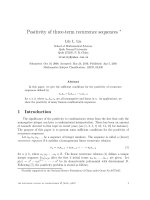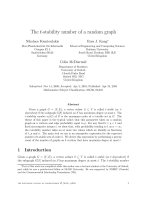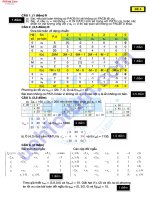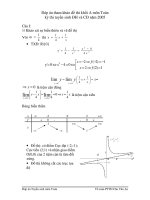Toán
Bạn đang xem bản rút gọn của tài liệu. Xem và tải ngay bản đầy đủ của tài liệu tại đây (114.17 KB, 9 trang )
Positivity of three-term recurrence sequences
∗
Lily L. Liu
School of Mathematical Sciences
Qufu Normal University
Qufu 273165, P. R. China
Submitted: Oct 10, 2008; Accepted: Mar 24, 2010; Published: Apr 5, 2010
Mathematics Subject Classification: 11B37, 05A20
Abstract
In this paper, we give the sufficient conditions for the positivity of recurrence
sequences defined by
a
n
u
n
= b
n
u
n−1
− c
n
u
n−2
for n 2, where a
n
, b
n
, c
n
are all nonnegative and linear in n. As applications, we
show the positivity of many famous combinatorial sequences.
1 Introduction
The significance of the positivity to combinatorics stems from the fact that only the
nonnegative integer can have a combinatorial interpretation. There has been an amount
of research devoted to this topic in recent years (see [1, 2, 5, 9, 10, 14, 15] for instance).
The purpose of this paper is to present some sufficient conditions for the positivity of
recurrence sequences.
Let u
0
, u
1
, u
2
, . . . be a sequence of integer numbers. The sequence is called a (linear)
recurrence sequence if it satisfies a homogeneous linear recurrence relation
u
n
= a
1
u
n−1
+ a
2
u
n−2
+ ··· + a
k
u
n−k
(1)
for n k, where a
1
, a
2
, . . . , a
k
∈ Z. The linear recurrence relation (1) defines a unique
integer sequence {u
n
}
n0
after the first k initial terms u
0
, u
1
, . . . , u
k−1
are given. Let
p(x) = x
k
− a
1
x
k−1
− ··· − a
k
be its characteristic polynomial with discriminant D.
Following [7], the positivity problem is stated as follows.
∗
Partially supported by the National Science Foundation of China under Grant No.10771027.
the electronic journal of combinatorics 17 (2010), #R57 1
Positivity Problem. Let a linear recurrence relation (1) be given together with the initial
terms u
i
for i = 0, 1, . . . , k− 1. Is the recurrence sequence {u
n
}
n0
nonnegative, i.e., does
it hold that u
n
0 for all n?
So far there have been some results on the positivity problem. For example, Halava
et al [7] presented that the positivity problem is decidable for three-term recurrence se-
quences defined by
u
n
= au
n−1
+ bu
n−2
(2)
for a, b ∈ Z. More precisely, we can conclude the following result from [7] when ab = 0.
Theorem 1.1. Suppose that the sequence {u
n
}
n0
satisfying the three-term recurrence
relation (2) with the discriminant D = a
2
+ 4b 0. Let λ and Λ be the smaller and
larger characteristic roots respectively. Then the full sequence {u
n
}
n0
is nonnegative if
and only if one of the following conditions hold.
(i) a > 0, b < 0 and u
1
u
0
λ 0.
(ii) a < 0, b > 0 and u
1
= u
0
Λ 0.
In this paper, we are mainly interested in the positivity problem of sequences satisfying
the following more general recurrence
a
n
u
n
= b
n
u
n−1
− c
n
u
n−2
, (3)
where a
n
, b
n
, c
n
are all nonnegative and linear in n. There are many combinatorial se-
quences satisfying this recurrence. For example, the central Delannoy sequence {D(n)}
satisfies the recurrence
nD(n) = 3(2n − 1)D(n − 1) − (n − 1)D(n − 2) (4)
with D(0) = 1, D(1) = 3 and D(2) = 14 (see [12] for instance). However, we cannot get
that the sequence {D(n)} is nonnegative directly from the recurrence (4).
The paper is organized as follows. In Section 2, we present the sufficient conditions
used frequently for the positivity of sequences satisfying the recurrence (3). In Section 3,
we apply these results to derive the positivity of several combinatorial sequences, including
the central Delannoy numbers, the Schr¨oder numbers, and some orthogonal polynomials.
Finally in Appendix, we prove Proposition 2.1.
2 Sufficient conditions for the positivity
In this section, we give the sufficient conditions for the positivity of {u
n
} satisfying
the recurrence
a
n
u
n
= b
n
u
n−1
− c
n
u
n−2
,
the electronic journal of combinatorics 17 (2010), #R57 2
where u
0
, u
1
0 and a
n
, b
n
, c
n
are all nonnegative. Let x
n
=
u
n
u
n−1
for n 1. In order to
establish the positivity of the sequence {u
n
}, it sufficies to check that {x
n
}
n1
satisfies
x
n
c
n+1
b
n+1
.
By (3), the sequence {x
n
}
n1
satisfies the recurrence
a
n
x
n
= b
n
−
c
n
x
n−1
.
Let p
n
(x) = a
n
x
2
− b
n
x + c
n
denote the n-th characteristic polynomial of the sequence
satisfying the recurrence (3). Assume that b
2
n
− 4a
n
c
n
0 for each n 1. Then the n-th
characteristic roots are
λ
n
=
b
n
−
b
2
n
− 4a
n
c
n
2a
n
and Λ
n
=
b
n
+
b
2
n
− 4a
n
c
n
2a
n
respectively. Denote the limit of the sequence {λ
n
}
n1
by λ
∞
. By a simple calculation
and b
2
n
4a
n
c
n
, we have
λ
n
c
n
b
n
.
Hence we can conclude that if u
0
, u
1
0 and x
n
λ
n+1
for n 1, then the sequence
{u
n
}
n0
is nonnegative.
In the following, we suppose that a
n
, b
n
, c
n
are all linear in n. More precisely, let
a
n
= α
1
n + α
0
, b
n
= β
1
n + β
0
, c
n
= γ
1
n + γ
0
and denote
A =
β
0
β
1
γ
0
γ
1
, B =
γ
0
γ
1
α
0
α
1
, C =
α
0
α
1
β
0
β
1
.
We can obtain the monotonicity of the n-th characteristic roots {λ
n
}
n1
and {Λ
n
}
n1
,
which is only related to discriminants A, B, C.
Proposition 2.1. Suppose that B
2
AC. Then the following hold.
(i) If C 0, then sequences {λ
n
}
n1
and {Λ
n
}
n1
are nonincreasing in n.
(ii) If C > 0, then sequences {λ
n
}
n1
and {Λ
n
}
n1
are nondecreasing in n.
For the sake of the flow, the proof of Proposition 2.1 is given as an Appendix.
We can now give the following sufficient conditions for the positivity of recurrence
sequences satisfying (3).
Theorem 2.2. Let {u
n
}
n0
be a sequence of integer numbers and satisfy the three-term
recurrence (3). Suppose that C 0, B
2
AC and u
1
u
0
λ
1
0. Then the positivity
problem of the sequence {u
n
}
n0
can be solved.
the electronic journal of combinatorics 17 (2010), #R57 3
Proof. Let x
n
=
u
n
u
n−1
for n 1. We need to prove that x
n
λ
n+1
for all n 1. From
Proposition 2.1 (i), we have λ
n
λ
n+1
. Hence it suffices to show x
n
λ
n
. We proceed
by induction on n. Clearly, x
1
λ
1
by the condition u
1
u
0
λ
1
0. Now assume that
x
n−1
λ
n−1
for n 2. Note that p
n
(λ
n
) = 0, i.e. b
n
−
c
n
λ
n
= a
n
λ
n
. So we have
a
n
x
n
= b
n
−
c
n
x
n−1
b
n
−
c
n
λ
n−1
a
n
λ
n
.
by induction hypothesis and Proposition 2.1 (i). Thus x
n
λ
n
for all n 1. This
completes the proof.
Theorem 2.3. Let {u
n
}
n0
be a sequence of integer numbers and satisfy the three-term
recurrence (3). Suppose that C > 0, B
2
AC, Λ
1
λ
∞
and u
1
u
0
Λ
1
0. Then the
positivity problem of the sequence {u
n
}
n0
can be solved.
Proof. Let x
n
=
u
n
u
n−1
. In order to prove the positivity of {u
n
}, it suffices to check that
x
n
λ
n+1
for all n 1. From Proposition 2.1, we have Λ
1
λ
n+1
. So we only need to
show that x
n
Λ
1
. We proceed by induction on n. Clearly, x
1
Λ
1
by the condition
u
1
u
0
Λ
1
0. Now assume that x
n−1
Λ
1
for n 2. Note that λ
n
Λ
1
Λ
n
following
from Proposition 2.1 and the condition Λ
1
λ
∞
. Hence p
n
(Λ
1
) = a
n
Λ
2
1
− b
n
Λ
1
− c
n
0.
Furthermore,
a
n
x
n
= b
n
−
c
n
x
n−1
b
n
−
c
n
Λ
1
a
n
Λ
1
by the induction hypothesis. Then x
n
Λ
1
for all n 1. The proof is complete.
When a
n
, b
n
, c
n
are all constants, we have A = B = C = 0 by the definition. So
the sufficiency of Theorem 1.1 (i) is a special case of Theorem 2.2. In particular, if
B
2
= AC, then we can obtain the following corollary which is interesting and useful from
Proposition 2.1, Theorems 2.2 and 2.3.
Corollary 2.4. Let {u
n
}
n0
be a sequence of integer numbers and satisfy the three-term
recurrence (3). Suppose that B
2
= AC. Then the following results hold.
(i) If b
n
C + 2a
n
B has the same sign as C for all n 1, then the sequence {λ
n
}
n1
is
constant. In addition, if u
1
u
0
λ
1
0, then the positivity problem of the sequence
{u
n
}
n0
can be solved.
(ii) If b
n
C + 2a
n
B has opposite sign of C for all n 1, then the sequence {Λ
n
}
n1
is
constant. In addition, if u
1
u
0
Λ
1
0, then the positivity problem of the sequence
{u
n
}
n0
can be solved.
3 Applications
In this section, we apply results obtained in the previous section to derive the positivity
of several recurrence sequences in a unified manner.
the electronic journal of combinatorics 17 (2010), #R57 4
Let ν > −
1
2
be a parameter. The Gegenbauer polynomials sequence {C
(ν)
n
(t)}
n0
satisfies the recurrence relation
nC
(ν)
n
(t) = 2t(ν + n − 1)C
(ν)
n−1
(t) − (2ν + n − 2)C
(ν)
n−2
(t) (5)
with C
(ν)
0
(t) = 1 and C
(ν)
1
(t) = 2tν. Then we have the following corollary.
Corollary 3.1. The positivity problem of the Gegenbauer polynomials sequence {C
(ν)
n
(t)}
can be solved for t 1, ν
1
2
.
Proof. From the recurrence (5), we have A = −2t(ν − 1), B = 2(ν − 1), C = −2t(ν − 1).
Clearly, b
2
n
− 4a
n
c
n
= 4[(t
2
− 1)n
2
+ 2(ν − 1)(t
2
− 1)n + t
2
(ν − 1)
2
] 0 for t 1 by direct
calculation.
First consider the case t = 1. We have B
2
= AC and b
n
C + 2a
n
B = −4(ν − 1)
2
0.
If ν > 1, then C < 0. By Corollary 2.4 (i), we have λ
n
= 1 for n 1. And if
1
2
ν 1,
then C 0. By Corollary 2.4 (ii), we have Λ
n
= 1 for n 1. Thus the positivity of
{C
(ν)
n
(t)}
n0
follows from Corollary 2.4.
For t > 1, we have B
2
AC. If ν > 1, then C < 0 and if
1
2
ν 1, then C > 0.
Also, Λ
1
= tν +
√
t
2
ν
2
− 2ν + 1 and λ
∞
= t −
√
t
2
− 1. Thus the sequence {C
(ν)
n
(t)}
n0
is nonnegative from Theorems 2.2 and 2.3 respectively.
In particular, for ν =
1
2
, C
(
1
2
)
n
(t) reduces to the Legendre polynomials P
n
(t) and for
ν = 1, we have C
(1)
n
(t) = U
n
(t) is the Chebyshev polynomials of the second kind. So
the Legendre polynomials sequence {P
n
(t)}
n0
and the Chebyshev polynomials sequence
{U
n
(t)}
n0
are nonnegative for t 1.
The derivative sequence of Gegenbauer polynomials {
d
dt
C
(ν)
n
(t)}
n0
satisfies the follow-
ing recurrence relation
(n − 1)
d
dt
C
(ν)
n
(t) = 2t(ν + n − 1)
d
dt
C
(ν)
n−1
(t) − (2ν + n − 1)
d
dt
C
(ν)
n−2
(t) (6)
with
d
dt
C
(ν)
n
(0) = 0,
d
dt
C
(ν)
n
(1) = 2ν and
d
dt
C
(ν)
n
(2) = 4ν(ν+1)t. Then we have the following.
Corollary 3.2. The positivity problem of the derivative sequence of Gegenbauer polyno-
mials {
d
dt
C
(ν)
n
(t)}
n0
can be solved for t 1, ν > 0.
Proof. From the recurrence (6), we have A = −2tν, B = 2ν, C = −2tν. And b
2
n
− 4a
n
c
n
=
4[(t
2
− 1)n
2
+ 2(ν − 1)(t
2
− 1)n + t
2
(ν − 1)
2
+ 2ν − 1] 0 for t 1.
For t 1, ν > 0, we have C < 0 and B
2
AC. Also, x
2
= 2t(ν + 1) and Λ
2
=
t(ν + 1) +
t
2
(ν + 1)
2
− (2ν + 1). Thus the positivity of the sequence {
d
dt
C
(ν)
n
(t)}
n0
follows from Theorem 2.2.
In what follows we list some more examples of recurrence sequences which are easy
seen to satisfy the assumption of Theorem 2.3 or Corollary 2.4. Thus the positivity of
these sequences is an immediate consequence of Theorem 2.3 or Corollary 2.4.
the electronic journal of combinatorics 17 (2010), #R57 5









